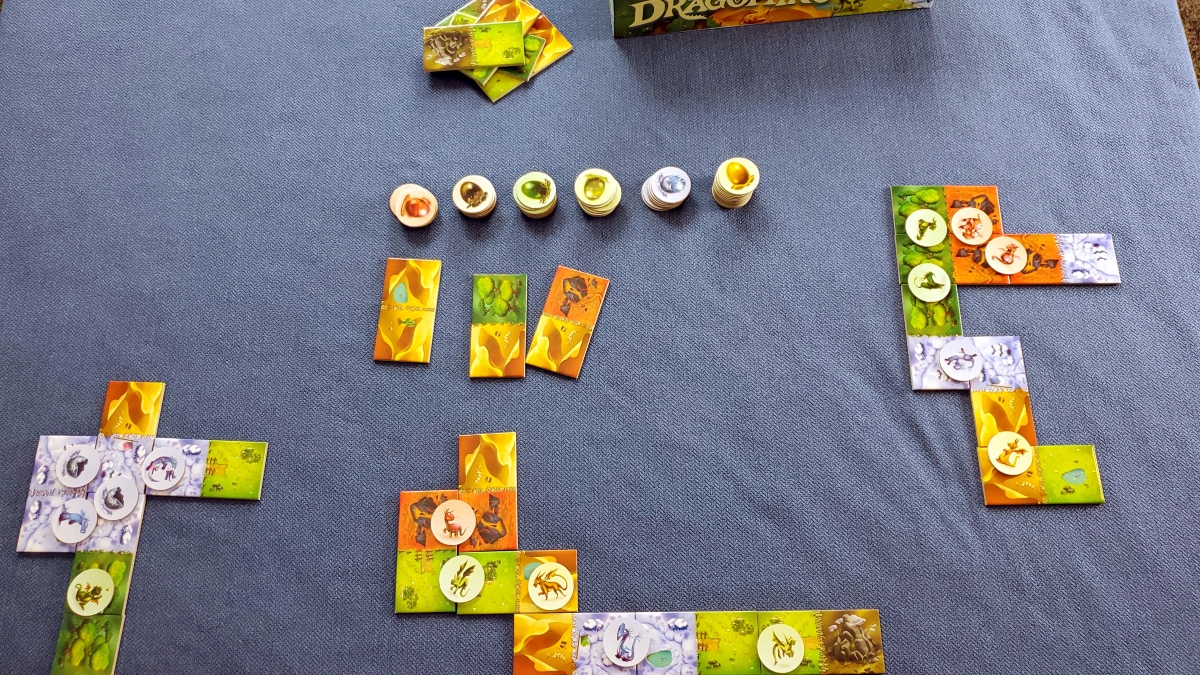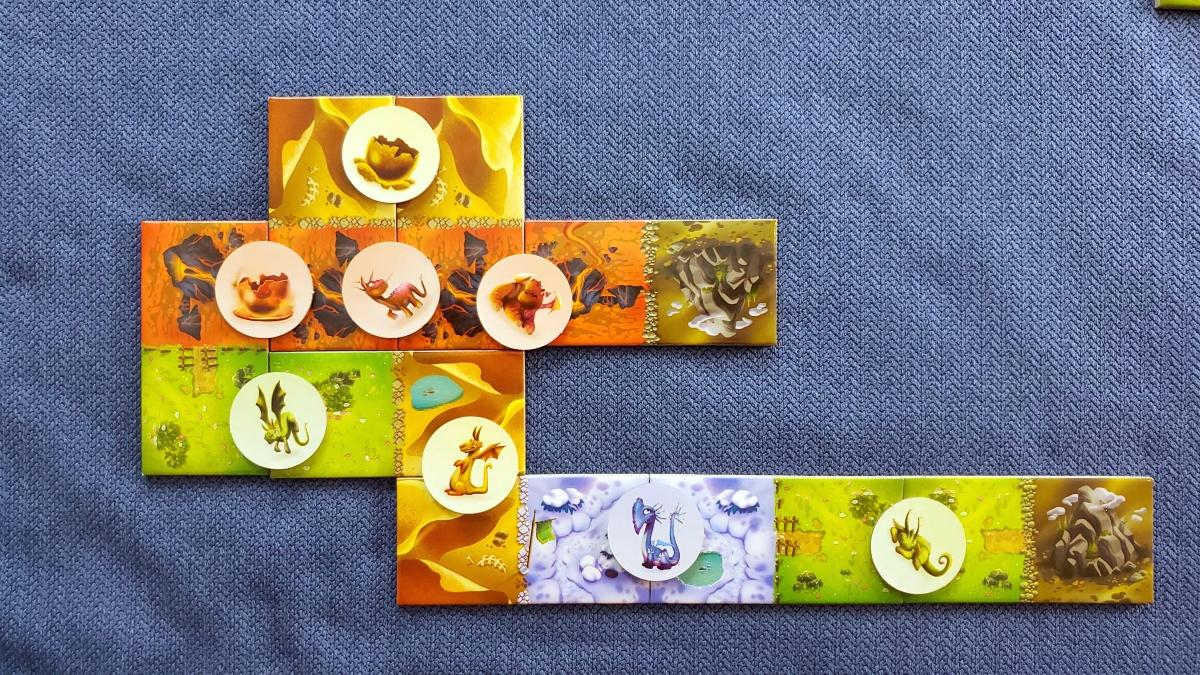
WE PLAY 2 LEARN
Game Ratings
FAMILY
7
YOUNG KIDS
8
OLDER KIDS
4
ADULTS
2
Overview
| Players | Playing Time | Best Age | Educational |
| 2 - 4 | 10 - 15 minutes | 3 - 10 | Math: Basic Probability Strategy Intro Matching |
| Skill | Luck | Strategy | Social | Game Type | Play Style |
| 40% | 60% | 50% | 50% | Tiles | Competitive |
What kid doesn't want to collect adorable baby dragons while exploring wild new lands? Dragomino does a great job grabbing kids attention right away with its cute artwork and bright landscapes. But
it will also keep them interested because of the straightforward and fast paced gameplay. This junior version of the 2017 game of the year, Kingdomino,
is meant for younger kids than that original game. Children as young as three can play it on their own, though kids up to ten will probably enjoy it as well.
For those that have played Kingdomino, the main differences are
- Tile placement is easier. There are no limits on board size or shape. And players don't need to create large blocks of the same landscape type to score points.
- Scoring is much simpler. Every turn, for each half of the selected tile a player matches to an existing landscape on their board, they get to take an egg token. If that egg has a baby dragon on the back side, it will be worth a point at the end of the game.
- Tile selection and turn order are more kid friendly. The tiles are not numbered and turn order is not decided by the tiles selected in the previous round. Instead, if a player finds an empty shell on the back side of their egg token, they get the Mommy Dragon token. Whoever has the Mommy Dragon at the end of the round will start the next round.



How to Play
LEARN THIS GAME IN OUR HOW TO PLAY VIDEO
Official Rules
The official rules are available here.
Enhanced Rules
This game is easier to setup and play with some minor changes as described in our Custom Rules section.
Fast Facts
How many players?
- Playable with 2-4
- Best with 2-4
What ages can play?
- Playable for ages 3 to adult
- Best for ages 3 to 10
Can different skill levels or ages play together?
Yes. Older or more strategic players would have a very slight advantage, but this presents a good chance to teach younger kids to begin thinking in a more strategic way.
How long does it take to play?
10 - 15 minutes, including setup time.
Will we get bored after a few games or does it have good replayability?
This is a very replayable game. Each game will be a little different because of the randomness in which tiles are available and how this drives players' decisions.
Setup/Cleanup
How much work is it?
Low. The tiles can be played right from the box and there is a way to make the rest of setup very quick as well (see our Custom Rules
section).
Would kids be able to do it on their own?
Kids as young as 3 or 4 could setup and clean-up this game on their own.
Will parents have fun too...
...when playing with the kids?
Parents will find this more enjoyable than many games intended for younger kids. However, it won't be challenging for parents or nearly as
interesting as Kingdomino, which also has ways to include younger kids as we describe here. But for those kids not yet ready for Kingdomino, this is a good
starting point as a family.
...without the kids?
No, adults will find Kingdomino much more interesting.
Educational Value
What skills will this game help develop?
Basic Probability
The six different landscapes in the game all have the same number of baby dragons available, but every landscape has a different amount of empty eggs that won't provide any points.
So players will need to decide which landscapes to collect and how to position them to give themselves the best chance of finding a point scoring baby dragon.
Strategy Introduction
Players will need to select and position their landscape tiles in ways that give them the best chance of finding a baby dragon. This may mean
passing on a tile that will give you one good match, for a different tile that gives you two lesser matches. These are great decisions to introduce younger kids to the basics of strategic thinking.
Matching (Pattern Recognition)
For very young kids, matching the landscape tiles can provide great practice while being part of family game time.
But will my kids actually have fun playing it?
Yes, the gameplay is quick and will hold kids' attention. The artwork and theme are a huge draw for kids as well.
Custom Rules
Decrease setup time
During setup, place all the eggs facedown in the box lid.
The official rules suggest placing each egg type in its own spot around the playing area. This requires
sorting all of the egg types between games and making sure each kind is shuffled well so all the dragon or empty shells aren't together from the previous game. This is by far the longest part of setup
for the game. For quicker setup we prefer to place all of the eggs facedown in the box lid and then can mix them all easily at the same time. This also makes cleanup easier because we do not
need to sort the different types of eggs out again when we put them away.
Highlight the probabiliy aspect of the game
During setup, place eggs in stacks that are ordered by probability
Here we place each egg type
in its own stack and arrange them in order from highest probability of a baby dragon (volcano) to lowest probability (desert). This is more work but it really helps kids to understand that each
terrain has a different chance of providing a baby dragon. This is especially true later in the game when kids can see that some stacks are smaller and then count the dragons already on the board
of that type to decide their best option.
Yes, these two suggestions are complete oppsites but each serves a different purpose. Use whichever works best for your family. We've found it helpful to sort the eggs by probability for new players
and then mix them together in the lid for those that have played many times before.
Do you use custom rules we haven't thought of? If you have found some other ways to customize the rules, please share them with us through our Contact page. We're always interested in new ways to improve gameplay.
Where to Buy
Similar Games
If you like this game, we suggest these others
Or check out our full list of Reviews where you can sort by any of these categories
We are a participant in the Amazon Services LLC Associates Program, an affiliate advertising program designed to provide a means for us to earn fees by linking to Amazon.com and affiliated sites





